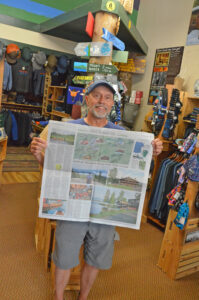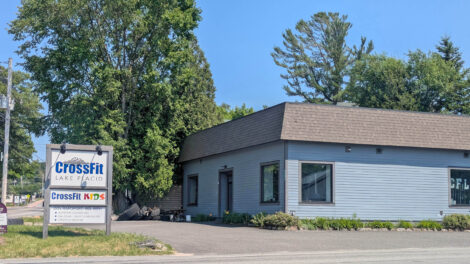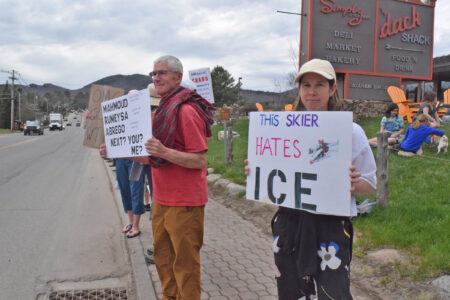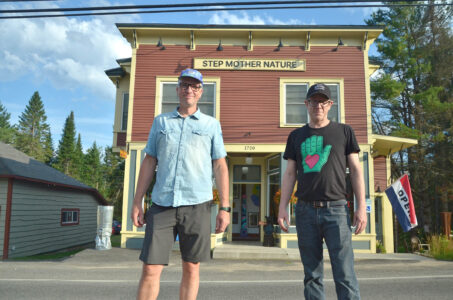New Adirondack Council head says he brings holistic view

Raul “Rocci” Aguirre is the new executive director of the Adirondack Council. (Provided photo — Emily Russell, North Country Public Radio)
The largest environmental nonprofit in the Adirondacks has a new leader. Raul “Rocci” Aguirre took the helm of the Adirondack Council last month and is the first person of color to lead the organization. Aguirre told Adirondack reporter Emily Russell that, despite the leadership shift, the mission of the Adirondack Council remains the same. Their conversation has been lightly edited for clarity.
ROCCI AGUIRRE: Our North Star is wilderness character [and] ecological integrity. I’m a former wilderness ranger. I believe deeply in the power of wilderness and landscapes that are open and wild. I see that being the central theme to the Adirondack Council’s work. But all of my 28 years of landscape-scale conservation work has really focused on holistic models. How do you engage communities? How do you engage across regions? And that will take time because we haven’t put the resources in other places that I see us doing in the coming years.
EMILY RUSSELL: Communities have always been integral to the Adirondack Park, but some of these places in the more rural pockets of the park are really struggling. Populations are declining, there are housing difficulties and employment problems. What actionable items can the Council take to address some of the biggest issues facing Adirondack communities?
AGUIRRE: I think it’s about sitting down and looking at issues like renewable energy and siting, and how those can be positive influences and where it’s appropriate. Cell towers — we believe that, as a whole, the cell tower policy has been largely effective. Is there room to find improvement there? I believe that we can try and do that in ways that increase that coverage for everybody and we look forward to being a part of those conversations.
Affordable housing — it’s trying to see where the intersection is between open space and conserved lands and really trying to find new models that might exist and being a facilitator for models that exist elsewhere or are being created elsewhere. The Hudson Valley has really started to look at how you can integrate green affordable housing into a conservation strategy. There’s not an easy answer to that, especially for a wilderness-based organization. But by creating truly vibrant communities to really create the presence and the infrastructure and the support that the communities need, it makes us more effective as advocates for the wilderness that we think is really one of the primary economic drivers for this region. It’s what makes this place so special.
RUSSELL: Part of creating vibrant communities and sustainable communities in the Adirondacks is diversifying year-round residents and the people that come to visit the park. The Adirondack Council is part of the Timbuctoo Climate and Careers Institute that’s starting up this summer. Are there other programs that the Council is also thinking about to really help diversify the park?
AGUIRRE: Well, the Council is a founding member of Adirondack Diversity Initiative, so we were there at the very beginning. I sat in at the very first symposiums that ADI held. As a person of color who has been in the conservation arena for almost 30 years, I know how challenging the diversity question is, especially in hyper-rural landscapes. I also understand the value and the need for that. A lot of times we talk about what makes the community welcoming and making the community accessible. I always say the first place you start is by making a community safe, and that’s partially born of my own experiences, it’s partially born of the experiences that my family has had, but it’s also just understanding how those experiences play into a place like the Adirondacks. It’s trying to elevate the conversation that not everybody sees this landscape as a sanctuary, right? And that there are conversations and education that need to happen in a much broader way.
RUSSELL: What are some of your big conservation goals in the next five to 10 years for the Council?
AGUIRRE: I do believe that taking a holistic view of park governance, not just one part of reform, like reforming the Adirondack Park Agency, or reforming the state Department of Environmental Conservation, or engaging around visitor use management. It’s to really see park governance — and that’s public and private lands — connected in ways that I don’t think we’ve really thought about. I really would love for us to really start to think and talk about the park as a whole. We really do tend to fragment the park into regions. They have distinct personalities, but I really think that there’s a benefit in us looking at how to manage the park across the entire 6 million acres.
RUSSELL: What would that actually look like? What systems in place would you want to see to make that happen?
AGUIRRE: So I think this is where you start to say, where is the Adirondack Park Agency’s role in starting to think holistically? I think it’s also for the Department of Environmental Conservation and seeing opportunities for their management to take on, rather than sort of a regional perspective, a park perspective, and to really try and create cohesion through their Region 5 and Region 6.
RUSSELL: How about the APA? What would you like to see them do differently?
AGUIRRE: I think it’s just to be able to put the resources across the park, and we really do need to sort of elevate the role that the APA has in the staffing and the resources. We come back to this issue all the time. You can’t serve the park in the best way possible without really having these agencies both fully staffed and given the resources that they need, and to really, truthfully start to look at how you bring in new talents, new skill sets, new civil service titles that allow you to bring in the technical expertise to allow a park to be managed as a park, to really allow the APA to have the staffing and the technical expertise to dig into all of the housing development issues that we’re seeing, map amendments. To look at the scale of a park that’s the size of Vermont and see what the APA does with such a limited budget and resources is amazing.
RUSSELL: What is your favorite way to experience the park?
AGUIRRE: So, I’m a recovering fly fishing guide and somebody who is drawn to water. So whether it’s in a boat, a canoe, or probably my most favorite way to just get away and explore the Adirondacks is with a fly rod. I’m also an avid hunter. I spend a great deal of time in the woods trying to put food on the table and really believe in the value of hunting and the power of the sporting community. Hunting and fishing are probably the two ways throughout my entire life that I’ve spent the most outside. And then we do all of the ancillary around-the-edges stuff like biking and hiking and all of that. I’ve spent my entire career and most of my adult life having a job that’s allowed me to play in some of the most amazing places and that’s always been a part of it — hunting, fishing, foraging, just trying to be out in whatever way I can.




